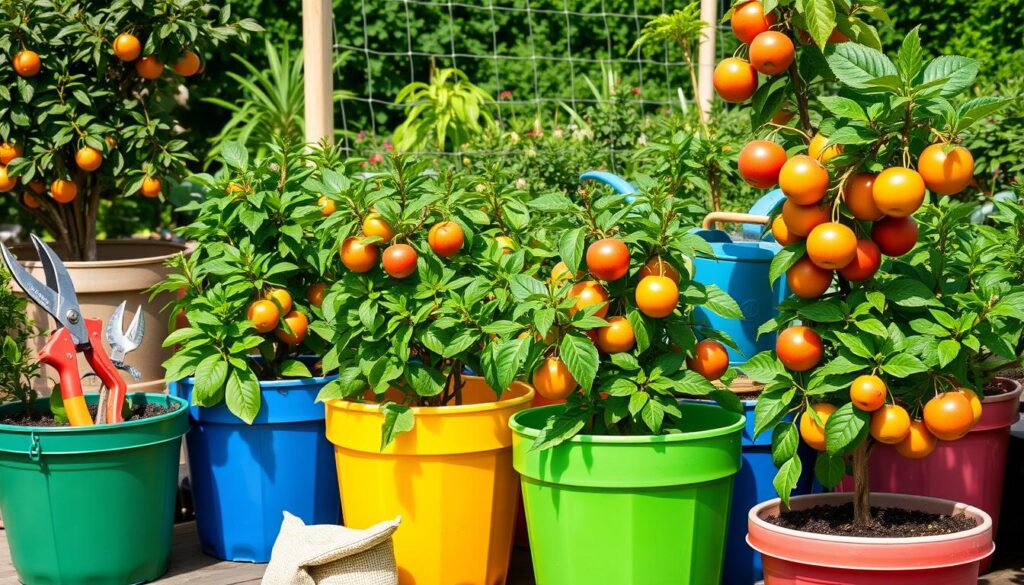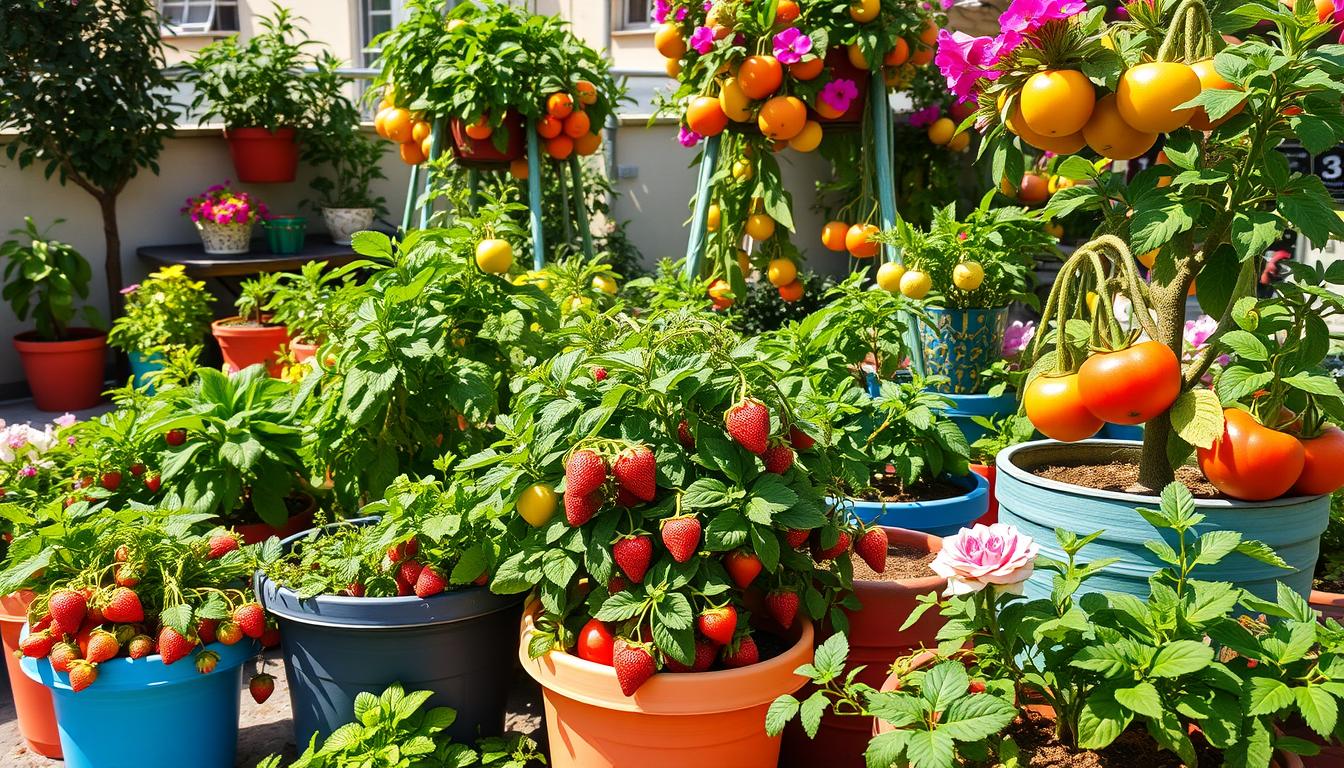In today’s cities, where space is limited, growing fruit in containers is a great solution. You can grow fresh fruits like strawberries and cherries even in a small apartment. With the right steps, anyone can enjoy a fruitful harvest from their potted plants.
Container gardening is more than just making your space look good. It’s about making the most of small spaces. I’ve found that picking the right containers, ensuring good drainage, and choosing the right fruits are key. With some tips, you can turn a balcony or patio into a fruit garden that’s both beautiful and fruitful.
Key Takeaways
- Container gardening enables fruit growing in limited spaces.
- Proper drainage is crucial for avoiding excess water retention.
- Not all fruit varieties are suitable for containers; select wisely.
- Tomatoes and squash may require larger containers, like 10 or 20 gallons.
- Watering frequency may increase during the hot summer months.
- Using vertical spaces helps maximize planting potential.
- Refresh potting mix every 2 to 3 years for optimal growth.
Understanding Container Gardening
Container gardening lets people garden even with little space. It’s perfect for city folks. It’s easy and flexible, making it a hit for those with small outdoor areas.
There’s a wide range of containers to choose from. You can pick from plastic to ceramic, matching your style. The right container should fit your space and look good too.
Choosing plants for containers depends on their light and water needs. Some plants need full sun, while others prefer shade. Knowing what each plant needs is key to keeping them healthy.
Getting your containers ready is crucial. Make sure they drain well to help roots grow. I use lighter potting soils to keep roots happy and prevent them from getting too crowded.
Recently, there are new, compact fruit varieties for container gardening. These make growing fruits like tomatoes and citrus trees in small spaces easy.
Looking after your container garden is important. It means knowing when to feed your plants and keeping them in the best condition. This way, you can enjoy a bountiful harvest and keep exploring gardening indoors or on balconies.
Choosing the Right Containers
Starting to grow potted fruit plants means picking the right containers is key. The type and shape of the pots affect your plants’ health. Knowing about drainage and size is crucial for a successful harvest.
Drainage Considerations
Good drainage stops waterlogging, a big problem for container gardeners. Choose pots made from durable materials like ceramic, fiberglass, or plastic. They help with drainage.
Make sure your pot has holes at the bottom for water to drain. Adding gravel or clay balls at the bottom helps even more. This simple trick can greatly help your plants.
Size Matters
The size of your containers is also very important. While some fruits do well in small pots, bigger pots are better for root growth. Start with pots that are 10 to 12 inches wide.
As plants grow, move them to bigger pots. Semi-dwarf trees need pots up to 20 to 25 gallons. Most fruit trees need a pot that’s 45-50 cm wide for the best growth.
Essential Soil Mix for Container Fruit Plants
Creating a good soil mix for container fruit plants is key for their growth and fruit production. I suggest using a high-quality potting mix made for container gardening. This mix holds moisture, gives nutrients, and drains well to support healthy roots.
High-Quality Potting Mix
The best potting mix has ingredients that help with aeration and keeping moisture. Peat moss, perlite, and vermiculite are good for this. Sand, silt, clay, coconut coir, compost, and pine bark also help. These ingredients make a versatile mix for growing fruit trees like dwarf apples, citrus, and figs in pots.
Additives for Better Drainage
To make your mix better, add horticultural grit or coarse sand. This helps with drainage, which is important to avoid soggy roots and diseases. It’s crucial to keep the right moisture levels in container gardening. A free-draining pot lets water move through the soil without getting too wet.
| Ingredient | Function | Benefits for Fruit Plants |
|---|---|---|
| Peat Moss | Misture retention | Prevents drying out |
| Perlite | Aeration | Promotes root oxygenation |
| Vermiculite | Nutrient holding | Improves nutrient retention |
| Pine Bark | Drainage enhancement | Breaks up compacted soil |
| Coarse Sand | Soil structure improvement | Facilitates drainage |
In summary, picking the right soil mix for container fruit plants is about mixing different elements for a balanced environment. With the right mix, fruit trees can grow well in containers and give a good harvest.
Watering Techniques for Container Plants
Watering container plants right is key to keeping them healthy. Potting soil dries out faster than garden soil. Plants in pots can get very dry in just one day during hot weather.
This makes it important to water them well and on time. In cities, knowing how and when to water can really help plants grow strong and healthy.
Assessing Moisture Levels
Checking soil moisture often is a must for container gardening. I suggest feeling the soil with your finger to see if it’s dry. This way, you can avoid plants getting too dry and dying.
Watering every five days is usually good, but bigger pots might need more time. If you can’t water for a while, using a kiddie pool to water plants works great. Just fill the pool with water and put the plants inside for them to soak up what they need.
Using systems that water plants for you or moisture meters can help keep plants hydrated. Mulching also helps keep soil moist and cool. It also stops water from evaporating too fast.
But, be careful with metal pots as they can get too hot. I like using plastic or glazed ceramic pots because they keep moisture in better.
Watering in the morning helps plants drink water all day. It also stops fungal diseases. Watering well helps roots grow deep and keeps water from just sitting on top.
By following these tips, my container plants do well even when I’m away. For more tips on gardening in the city, check out this guide on watering container plants.
Sunlight and Location for Your Container Garden
Choosing the right spot for your container fruit plants is key to their success. Most fruits need at least six to eight hours of direct sunlight each day. Using microclimates in your garden can also boost growth.
Identifying Microclimates
Microclimates are small areas with their own climate. They can have different temperatures, sunlight, and wind. To get the most sunlight for your garden, look for these microclimates:
- Sunny corners that get extra light from nearby buildings.
- Sheltered spots that protect plants from strong winds.
- Warm surfaces like brick or stone that soak up sunlight.
By placing containers in these spots, you ensure your plants get the best sunlight and protection. Containers dry out faster than plants in the ground, especially when it’s hot. Moving them around based on the sun’s path helps save water. On very hot days, you might need to water them twice a day to keep them moist.
With the right sunlight and placement, container gardening can produce lots of healthy fruit. By understanding how sunlight and environment work together, you can grow a thriving garden in any small space.
Drainage Solutions for Container Gardening
Drainage is key for healthy container plants. Without it, plants can drown in water, leading to root rot and death. I use various drainage solutions and hacks to keep plants well-aired and healthy.
Ensuring Proper Airflow
I ensure my containers have enough drainage holes. The number and position of these holes vary based on the planter’s size and material. For instance, clay and terracotta need fewer holes than glazed terracotta and plastic.
I also choose potting mixes with coconut coir, vermiculite, and perlite. These improve drainage and support root health. Using these mixes helps my plants grow better than with traditional soil.
When I find planters without holes, I get creative. I use a smaller pot inside or add rocks and charcoal for better airflow and moisture control.
For different materials, I use specific methods to create drainage holes. Drilling works for ceramic, while a soldering gun is best for plastic. These steps ensure air reaches the roots.
Choosing the right container and drainage solutions lets me grow many plants, even in small spaces. For those starting a container garden, check out these contact tips for effective gardening communication. The right setup boosts plant growth at every stage.

Growing Fruit in Containers: Tips and Tricks
Choosing the right fruit varieties is key for container gardening. It’s important to pick fruits that grow well in small spaces and look good together. Super dwarf fruit trees are perfect for small gardens or patios, growing up to 1.5 meters tall.
Choosing the Right Fruit Varieties
Here are some top picks for container gardening:
- Trixzie Nectazee Nectarine
- Trixzie Pixzee Peach
- Trixzie Pear cv. Pyvert
- Lemon Lots of Lemons
- Dwarf Tahitian Lime
These plants are great for containers and add a variety of flavors. Use pots that are at least 20 inches wide and 24 inches tall. This gives the roots enough room to grow.
Combining Plants for Variety
Planting different fruits together can make your garden look better and produce more. Pairing perennial fruits like strawberries and blueberries with dwarf trees means you can harvest fruit at different times. This also attracts good bugs, keeping your garden healthy.
By picking the right fruits and following these tips, you can enjoy a big harvest at home. For more tips, check out this link.
Feeding and Fertilizing Container Fruit Plants
Proper nutrition is key for the health and productivity of container fruit plants. I suggest a regular feeding schedule to help your plants grow well. Since container fruits need more nutrients than ground-grown ones, use slow-release fertilizers like Osmocote® or organic amendments.
When and How to Fertilize
Fertilizing at the right time boosts fruit production in container gardens. Fertilize mainly during the flowering and fruiting stages. This is when plants need the most nutrients.
Container plants use up nutrients quickly, often within six weeks. For best results, use slow-release fertilizer pellets. They feed plants for at least 60 days, sometimes up to 120 days. Organic options like fish meal pellets and cotton seed meal also work well.
Remember, don’t over-fertilize. It can harm your plants. Always follow the instructions on the fertilizer package. Adjust as needed based on your plants’ health. Reliable sellers like Stark Bros Nursery and Orchards Co. offer great fruit trees for your garden. For more on privacy policies in gardening, check this link.
By focusing on good fertilization and meeting your plants’ needs, you’ll get a great harvest from your container fruit plants.
Maintenance and Pruning Practices
Regular maintenance and effective pruning are key for healthy growth and high fruit yield in container gardens. Proper care ensures plants thrive in small spaces, producing plenty of fruit.
Encouraging Healthy Growth
Pruning is vital for shaping and keeping potted fruit trees healthy. Choosing dwarf cultivars makes pruning easier than with regular orchard trees. I remove dead, damaged, or diseased branches and clear the canopy to improve air flow.
This helps increase fruit production and tree health. Almost any fruit tree can do well in a pot, making it great for different gardening setups.
Keeping plants the right size and shape is important. Using the right pot size helps with growth. Containers from 10 to 15 gallons are big enough for growth but still easy to move. Starting with smaller pots, like 5 to 7 gallons, helps avoid root problems later.
Pruning times vary by fruit tree type. For deciduous trees, prune after they’re dormant or early spring. Prune when they naturally shed leaves and grow new ones. Repotting in spring can also be a pruning method, trimming roots and foliage.
Following these maintenance tips helps plants live longer and produce more. It makes growing fruit in containers very rewarding.

Conclusion
Starting a container fruit garden is a great way to grow your own food, even in cities. This guide has given you key urban gardening tips to help you grow your own food. With the right containers, soil, and care, you can grow lots of fruit, no matter your gardening skills.
Choosing the right containers, using organic soil, and keeping the soil moist are key. Also, using natural fertilizers and supporting good bacteria in the soil helps your plants grow strong. Ready-made plants are great for city gardeners who want easy gardening without losing quality.
Container gardening is easy and rewarding. By using these tips and adjusting them for your space, you can create a fruit garden. I hope you’ll start your gardening journey and enjoy growing and eating your own fruits.





Leave a Reply